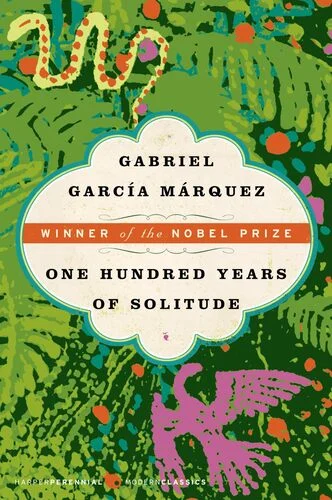Gabriel García Márquez’s One Hundred Years of Solitude is a masterwork of magical realism, known for its sweeping narrative and dreamlike atmosphere. At the heart of the novel lies Macondo, a fictional town that serves not merely as a backdrop, but as a powerful symbol. Through Macondo, Márquez explores the patterns of repetition, stagnation, and the illusion of progress that shape both the lives of its inhabitants and the larger arc of Latin American history.
Rather than functioning as a linear setting with a clear developmental trajectory, Macondo becomes an embodiment of cyclical history—a place where events, names, desires, and mistakes endlessly recur. Its very nature reflects the novel’s central themes: the inescapability of fate, the fragility of memory, and the human tendency to repeat the past, often without understanding it.
A Town Born from Isolation
Macondo begins as an isolated paradise, founded by José Arcadio Buendía in a moment of hopeful exploration. This founding myth gives Macondo a near-biblical origin, as if it were a second Eden untouched by the external world. However, even in its origins, we see the seeds of repetition: José Arcadio’s obsession with science, mirrors, and impossible inventions mirrors the obsessive tendencies that will plague his descendants.
Macondo’s isolation is not merely geographic. It is intellectual and emotional, too. The characters repeatedly struggle to make sense of the world, but often fail to retain knowledge or build upon it. This cultural amnesia ensures that every generation repeats the trials of the last, reinforcing the idea that Macondo exists in a loop rather than on a path of progression.
The Repetition of Names and Fates
One of the most striking motifs in the novel is the recurrence of names—José Arcadio, Aureliano, Remedios—assigned to each new generation. These names do more than honor ancestors; they bind the characters to inherited roles and fates. Aurelianos tend to be introspective, idealistic, and melancholic. José Arcadios are impulsive, physical, and often doomed by passion.
By using names as narrative echoes, Márquez reinforces the concept of cyclical identity. The characters are not only repeating the actions of their forebears—they are, in many ways, indistinguishable from them. This symbolic inheritance traps them in historical reenactment, unable to escape the shadows cast by those who came before.
The structure of the Buendía family becomes a metaphor for Macondo itself: expansive, branching, yet always circling back to the same dilemmas, obsessions, and downfalls.
The Mirage of Progress
Throughout the novel, Macondo experiences moments of apparent advancement. The arrival of the railroad, the telegraph, and the banana company suggests that the town is being pulled into modernity. Yet these developments are superficial and often destructive. Technological progress brings with it exploitation, environmental degradation, and social unrest—most tragically embodied in the massacre of striking workers, an event that is swiftly forgotten by all but one witness.
This selective memory is a core feature of cyclical history. In Macondo, significant events fail to leave lasting marks. The town grows and collapses in waves, but no permanent lesson is learned. New generations are unaware or indifferent to past catastrophes, and thus are doomed to relive them.
Márquez critiques the notion that modernization and time inherently bring enlightenment. In Macondo, the future becomes a repetition of the past, not a departure from it.
Magical Realism and Temporal Fluidity
The use of magical realism in One Hundred Years of Solitude further blurs the line between linear and cyclical time. Ghosts walk among the living, prophecies unfold slowly, and time seems to bend upon itself. Characters sense the repetition of events but are powerless to act upon it, as if caught in a spell.
This elastic sense of time contributes to Macondo’s symbolic weight. The town does not exist within history—it is a meditation on history, memory, and the futility of trying to impose order on the chaos of human experience. Time loops back on itself not only in plot but in form, as the narrative folds and refracts in hypnotic rhythms.
The surreal events of the novel, such as Remedios the Beauty’s ascension to the sky or the insomnia plague that robs townspeople of their memories, are not deviations from reality but manifestations of deeper historical truths: forgetting, repetition, and the impossibility of escaping the past.
The Buendía Family as Historical Allegory
The Buendía lineage mirrors the rise and fall of Macondo. Each generation is marked by recurring obsessions, loves, and tragedies. Incestuous relationships reappear, scientific curiosity mutates into madness, and political idealism ends in disillusionment. As the family tree spirals inward, it becomes increasingly self-referential, culminating in a final generation that is both the product and the victim of this closed circuit.
By tying the family’s fate to that of the town, Márquez suggests that personal and collective history are intertwined. The failures of the Buendías are not isolated errors—they reflect broader societal patterns. The past is not simply remembered in Macondo—it is reenacted, almost ritualistically.
In this way, the Buendías become avatars of Latin America’s historical cycles: revolution followed by repression, hope followed by corruption, creation followed by destruction.
The Prophecy and the End
The novel’s conclusion solidifies the symbolic nature of Macondo’s cyclical existence. As Aureliano Babilonia deciphers the ancient parchments written by the gypsy Melquíades, he realizes that the Buendía family’s entire history had been foretold. The revelation is not empowering—it is final. The story ends at the exact moment it is understood, suggesting that the act of understanding comes too late to change anything.
This ending reinforces the novel’s meditation on history as a closed system. The prophecy’s existence implies that free will is illusory and that the events of the past are destined to recur. Macondo’s destruction is not just physical—it is the collapse of a system unable to evolve beyond its patterns.
The town disappears, not in a cataclysmic war or revolution, but in a quiet folding-in of its own mythos. Its erasure is the final loop, completing a story that was always meant to be circular.
Macondo as Memory, Myth, and Mirror
Macondo, in One Hundred Years of Solitude, is not a town governed by geography, politics, or economy—it is a space defined by the cyclical nature of human experience. Through its repeated names, mirrored events, and mythic storytelling, it becomes a symbol of how individuals and societies fall into familiar traps, fail to retain wisdom, and resist true change.
Gabriel García Márquez transforms Macondo into a mirror, reflecting not only the history of Latin America but the broader human tendency to mistake motion for progress. In the town’s dreamy streets and haunted houses, we are reminded that time does not always move forward—and that understanding our cycles may be the only way to escape them.


